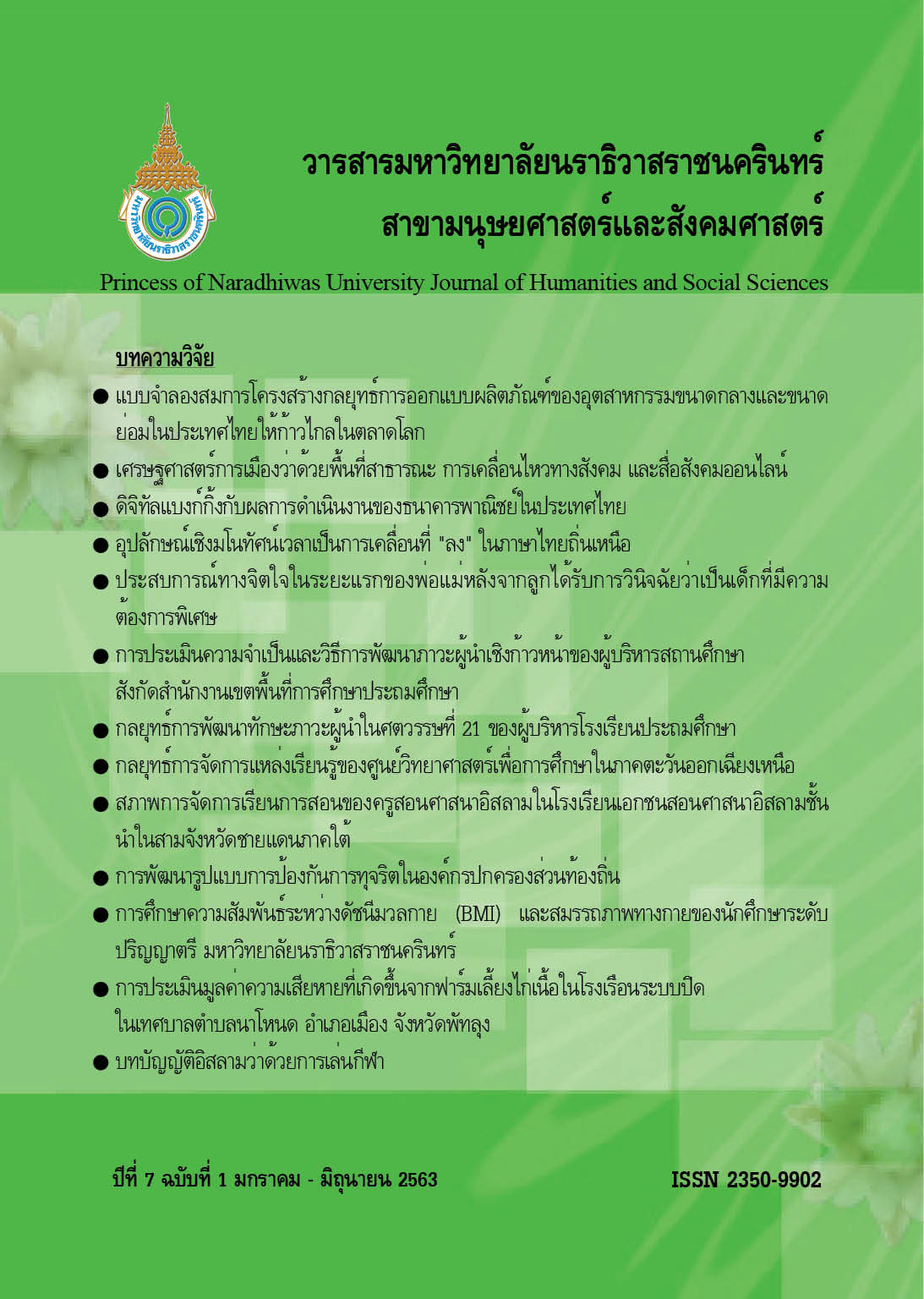The Study of Relationship between Body Mass Index (BMI) and Physical Fitness of Undergraduate Students, Princess Naradhiwas University -
Main Article Content
Abstract
This research aimed 1) to study the body mass index (BMI) and physical fitness and 2) to study the
relationship between body mass index (BMI) and physical fitness of undergraduate students, Princess of
Naradhiwas University. The sample used in this study was 131 students enrolled in health exercise course,
the 1st semester of academic year 2018. The research tools used in this study were data recording form of
body mass index (BMI) and of physical fitness, according to the test manual and standard of physical fitness of
Thai people aged from 19 to 59 years, which the manual is derived from Sport Science Bureau under
Department of Physical Education. The data was analyzed using statistics: mean (X), standard deviation (S.D.),
percentage and pearson correlation coefficient. (S.D.), percentage and pearson correlation coefficient.
The study found that: 1) Level of body mass index (BMI) of undergraduate students, Princess of Naradhiwas University overall is at asymmetry level (X=22.21, S.D.=4.363, standard levelX=2.97, standard level S.D.=0.538); 2) Level of physical fitness of undergraduate students, Princess of Naradhiwas University overall is at a high level (X=3.58, S.D.=0.538) and 3) Level of body mass index (BMI) related to physical fitness in a negative and it had statistical significance (p = 0.05), Which means that if the student has a better body mass index (BMI), physical fitness will increase.
Article Details
References
กลุ่มวิทยาศาสตร์สุขภาพ สำนักวิทยาศาสตร์การกีฬา กรมพลศึกษา กระทรวงการท่องเที่ยวและกีฬา. (2561). โภชนาการกับการออกกำลังกาย. กรุงเทพฯ: หจก. รวิน พริ้นติ้ง กรุ๊ป.
ไชยวัฒน์ นามบุญลือ, วรชิต พรหมน้อย, อภิรักษ์ คำเสนาะ, สโรชา อยู่ยงสินธุ์ และภาคภูมิ พันธ์นิกุล. (2560). สุขสมรรถนะของนักศึกษาที่เรียนรายวิชาการเสริมสร้างสมรรถภาพทางกายมหาวิทยาลัยราชภัฏอุบลราชธานี. วารสารศรีวนาลัยวิจัย, 7(1), 57-68.
ธงชัย วงศ์เสนา. (2559). การทดสอบและสร้างเกณฑ์มาตรฐานสมารรถภาพทางกายเพื่อสุขภาพนักศึกษาวิทยาศาสตร์การกีฬา มหาวิทยาลัยราชภัฏภาคตะวันเฉียงเหนือตอนล่าง. วารสารบัณฑิตวิทยาลัย มหาวิทยาลัยราชภัฏสุรินทร์, 10(2), 1-12.
นำโชค บัวทอง. (2556). สมรรถภาพทางกายเพื่อสุขภาพของนิสิตระดับปริญญาตรีชั้นปีที่ 1 มหาวิทยาลัยทักษิณ วิทยาเขตสงขลา. วิทยานิพนธ์ปริญญาการศึกษามหาบัณฑิต สาขาวิชาพลศึกษา มหาวิทยาลัยทักษิณ.
บุญชม ศรีสะอาด. (2535). หลักการวิจัยเบื้องต้น (พิมพ์ครั้งที่ 3). กรุงเทพฯ : สุวีริยาสาสน.
ปัณรสี เอี่ยมสะอาด, อำนวย สะอิ้งทอง และณัฐญวรรธน์ สถิราวิวัฒน์. (2556). การศึกษาสมรรถภาพทางกายเพื่อสุขภาพของนักศึกษา มหาวิทยาลัยราชภัฏนครปฐม. วารสารบัณฑิตศึกษา มหาวิทยาลัยราชภัฏสกลนคร, 10(46), 61-69.
วรศักดิ์ เพียรชอบ. (2561). รวมบทความเกี่ยวกับปรัชญา หลักการ วิธีสอน และการวัดเพื่อประเมินผลทางการพลศึกษา. กรุงเทพฯ: สำนักพิมพ์แห่งจุฬาลงกรณ์มหาวิทยาลัย.
สำนักวิทยาศาสตร์การศึกษา กรมพลศึกษา กระทรวงการท่องเที่ยวและกีฬา. (2559). คู่มือแบบทดสอบและเกณฑ์มาตรฐานสมรรถภาพทางกายสำหรับประชาชนไทยอายุ 19-59 ปี (พิมพ์ครั้งที่ 2). กรุงเทพฯ: สำนักวิทยาศาสตร์การศึกษา กรมพลศึกษา กระทรวงการท่องเที่ยวและกีฬา.
Yamane, T., (1973). Statistics : An Introductory Analysis (3rd ed.). New York: Harper and Row.


